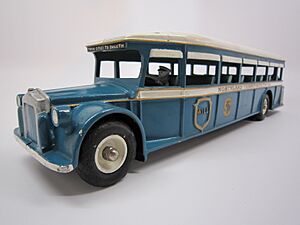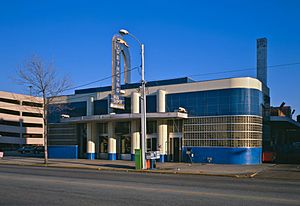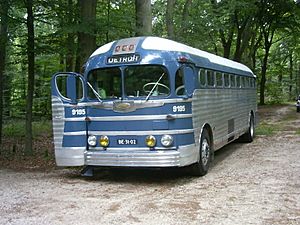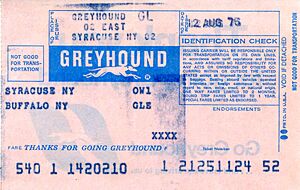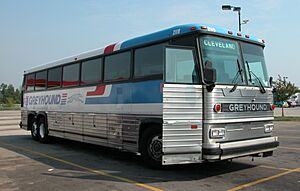Greyhound Lines facts for kids
 |
|
|---|---|
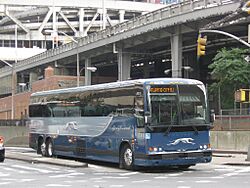
A Prevost X3-45 operated by Greyhound in New York City, August 2009
|
|
| Parent | Flix SE |
| Founded | 1914 by Carl Wickman in Hibbing, Minnesota, U.S |
| Headquarters | 350 North Saint Paul Street Dallas, Texas, U.S. |
| Service area |
|
| Service type | Intercity bus service |
| Alliance | FlixBus |
| Routes | 123 routes (includes Greyhound Express routes) |
| Stations | 230 (company operated) |
| Fleet | 1,700 motorcoaches, mostly 45-ft MCI 102DL3, G4500, D4505, and Prevost X3-45 |
| Fuel type | Diesel |
| Chief executive | David Leach (President and CEO) |
Greyhound Lines, Inc. is a well-known American company that provides bus services between cities. It has the largest network of intercity buses in the United States. Greyhound also offers special bus trips and services that connect with Amtrak trains. The company also runs buses in Mexico.
Greyhound's main office is in Dallas, Texas. It is part of a larger company called Flix SE, which also owns FlixBus. Greyhound uses about 1,700 buses, mostly made by Motor Coach Industries and Prevost. These buses serve 230 stations and travel to 1,700 different places. The company started its first bus route in Hibbing, Minnesota, in 1914. It officially became "Greyhound" in 1929.

Contents
- History of Greyhound Buses
- Important Incidents and Accidents
- See also
History of Greyhound Buses
How Greyhound Started (1914–1930)
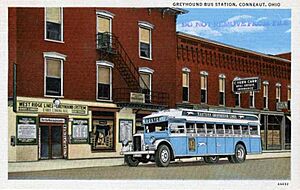
In 1914, a 27-year-old Swedish immigrant named Eric Wickman lost his job at a mine in Alice, Minnesota. He then started selling Hupmobile cars in Hibbing, Minnesota. When he couldn't sell one of his cars, he decided to use it to give rides to iron ore miners. He charged 15 cents for a two-mile trip from Hibbing to Alice. On his first trip, Wickman earned $2.25.
The first winter was tough because of the bad driving conditions in Minnesota, and Wickman almost quit. But he decided to keep going and hired others to drive. In 1915, he added a 15-mile route to Nashwauk, Minnesota. In December 1915, Wickman joined his company with Ralph Bogan's similar service to form the Mesaba Transportation Company. By 1918, they had 18 vehicles and earned $40,000 a year.
Wickman and his partner, C. A. A. "Arvid" Heed, later sold their shares in Mesaba Transportation Company. They moved to Duluth and bought White Bus Lines. In 1924, Wickman started Northland, which bought Superior-White Company. Orville S. Caesar, who was very good at business and mechanics, became president of the company. By 1925, Northland had bought eight more bus lines in Minnesota. In 1928, Northland bought most of Mesaba Transportation Company's routes.
The company grew quickly. By 1928, it was earning $6 million and offering trips across the United States. In 1929, it bought the Yelloway-Pioneer System, which had made the first bus trip across the country in 1928. It also bought The Pickwick Corporation.
In 1929, the company also bought parts of Gray Line Worldwide and Colonial Motor Coach Company, creating Eastern Greyhound Lines. It also bought a share of Northland Transportation Company and renamed it Northland Greyhound Lines.
Growing Stronger (1930–1945)
By 1930, over 100 bus lines had joined together under one main company, called Motor Transit Corporation. The company partners wanted a name that people would remember easily. They changed the name to The Greyhound Corporation, inspired by the fast dog breed. Legend says a driver named Ed Stone thought a passing bus looked like a greyhound dog.
Also in 1930, the company moved its main office from Duluth, Minnesota to Chicago, Illinois.
The company faced challenges during the Great Depression in the early 1930s, owing over $1 million by 1931. However, as the economy improved, Greyhound started to do well again.
In 1934, bus lines, with Greyhound being the largest, carried about 400 million passengers. This was almost as many as the major railroads. The movie It Happened One Night (1934), which showed a rich woman traveling by Greyhound bus, is said to have made bus travel more popular across the country.
In 1935, the number of bus passengers grew by 50% to over 651 million, passing the number of passengers on railroads for the first time. In 1935, Wickman reported record profits of $8 million. By 1936, Greyhound was already the biggest bus company in the U.S. and started getting 306 new buses.
In 1941, the company bought Greyhound Canada.
Between 1937 and 1945, Greyhound built many new stations and bought new buses. These buildings and buses often had a sleek, modern design called Streamline Moderne. Famous architects like William Strudwick Arrasmith and George D. Brown designed these stations. Examples include the Blytheville Greyhound Bus Station and the Columbia, South Carolina Greyhound Bus Station.
Greyhound worked with the Yellow Coach Manufacturing Company to create its streamlined buses. They bought 1,256 of these "Super Coach" buses between 1937 and 1939.
By the start of World War II, Greyhound had 4,750 stations and nearly 10,000 employees.
Growth and Changes (1945–1983)
Eric Wickman retired as president of Greyhound in 1946. His long-time partner, Orville S. Caesar, took over. Wickman passed away in 1954 at age 66.
Greyhound hired famous designer Raymond Loewy and worked with General Motors to create unique bus designs from the 1930s to the 1950s. One famous design was the "Silversides" bus. In 1954, Greyhound introduced its special two-level buses, known as the PD-4501 Scenicruiser.
After World War II, more people started traveling by car, especially with the new Interstate Highway System built from 1956. Air travel also became more affordable. These changes led to fewer people riding Greyhound buses.
In 1953, Greyhound bought the Tennessee Coach Company and also negotiated to acquire Blue Ridge Lines.
Freedom Rides and Civil Rights
In 1955, a government ruling stated that bus services like Greyhound's could not separate passengers by race. In 1960, the U.S. Supreme Court ruled that it was wrong to convict an African American person for being in a "whites only" area of a bus terminal.
In May 1961, Civil Rights Movement activists organized "Freedom Rides." These rides involved both Black and white passengers traveling together on buses to show that the desegregation rules should be followed. During these rides, some buses, including a Greyhound bus, were attacked by angry groups of people. Passengers were hurt, but these events helped bring attention to the need for equal rights.
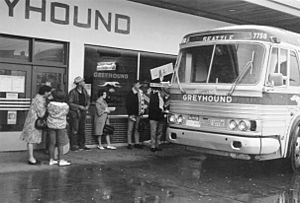
The Civil Rights Act of 1964 later made it illegal to discriminate based on race in public places like hotels, restaurants, and government buildings, as well as on transportation like Greyhound buses.
Changes in the 1960s, 70s, and 80s
As fewer people rode buses in the late 1960s, Greyhound's leaders started investing in other types of businesses.
In 1966, Gerald H. Trautman became the company's president and CEO.
In 1970, Greyhound bought Armour and Company, a meat-packing company that owned the Dial soap brand.
In 1971, Greyhound moved its headquarters to Phoenix, Arizona.
The company also bought other businesses, including a money order company, bus manufacturing companies (MCI and TMC), and an airline leasing business.
In the late 1970s, Greyhound began hiring African American and female drivers for the first time.
In 1972, Greyhound introduced the "Ameripass," which allowed unlimited bus travel for a set price. It was very popular for people traveling across the U.S. on a budget. Over time, the price increased, and it was eventually stopped in 2012.
Greyhound also bought Premier Cruise Line in 1984. For several years, Premier was the "Official Cruise Line of Walt Disney World" and had Disney characters on board.
Challenges and Changes (1983–2001)
1983 Greyhound Driver Strike
In 1983, Greyhound had 3,800 buses and carried about 60% of all intercity bus travelers in the U.S.
Starting in November 1983, Greyhound faced a big strike by its drivers. There were some serious incidents during the strike. A new agreement was reached in December 1983, and drivers returned to work.
New Owners and Mergers (1986–1990)
In 1987, a group of investors led by Fred Currey bought the bus line. Currey became the CEO and moved the headquarters back to Dallas, Texas.
In February 1987, Greyhound's new owners and the drivers' union agreed on a new contract.
In June 1987, Greyhound Lines bought Trailways, Inc., which was the biggest part of the rival Trailways Transportation System. This brought most of the country's bus services under one company.
For a few years, the old parent company of Greyhound Lines was still called The Greyhound Corporation, which caused some confusion. In 1990, it changed its name to Greyhound Dial Corporation, and then to The Dial Corporation in 1991, to avoid being confused with the bus company.
1990 Greyhound Driver Strike
In early 1990, the drivers' contract expired. In March, the union started another strike against Greyhound. This strike was also very difficult, with some violent incidents. Greyhound had to stop many of its routes and park most of its buses.
At the same time, new low-cost airlines like Southwest Airlines were becoming popular, which meant fewer people needed long-distance bus travel. Because of the strike, lower income, and higher costs, Greyhound had to file for bankruptcy in June 1990. The strike finally ended in May 1993, after 38 months. Greyhound agreed to pay money to the union drivers and bring many of them back to work.
After Bankruptcy (Early 1990s)
In August 1991, Greyhound came out of bankruptcy. It had fewer employees and buses than before.
In 1992, Greyhound changed some of its agreements with other bus companies, which led to a lawsuit from the U.S. Department of Justice. The government said Greyhound's actions were unfair to competition. In 1996, Greyhound agreed to change its practices.
By 1994, Greyhound's total income was $616 million. The company was offering very low fares because of competition.
In 1998, Greyhound promised to make its buses more accessible for passengers with disabilities, including adding wheelchair lifts to most buses.
More Mergers and Financial Trouble (2001)
In the late 1990s, Greyhound Lines bought two more parts of the National Trailways Bus System: Carolina Trailways in 1997 and Southeastern Trailways in 1998. After these purchases, most other Trailways companies either worked with Greyhound, stopped their regular routes, or focused on special trips.
In 1997, a Canadian company called Laidlaw announced it would buy Greyhound Canada, Greyhound's operations in Canada. In 1998, Laidlaw also bought Greyhound Lines in the U.S.
In June 2001, Laidlaw faced big financial losses and filed for bankruptcy protection in both the U.S. and Canada.
Under Laidlaw Ownership (2002–2007)
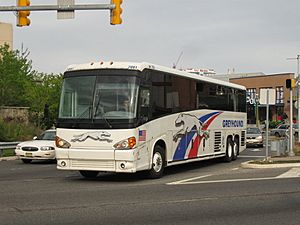
Laidlaw International, Inc. became a new company in 2003 after the bankruptcy.
By 2003, Greyhound faced strong competition in the Northeast U.S. from "Chinatown bus lines." These buses offered much lower prices than Greyhound. Between 1997 and 2007, these buses took a large share of Greyhound's business in that area.
In 2003, Greyhound expanded its QuickLink service, which offered frequent bus trips during busy commuting hours.
In 2004, Greyhound stopped serving less popular rural stops and focused more on busy routes between big cities. Local companies often took over the old rural stops, sometimes with government help.
Under FirstGroup Ownership (2007–2021)

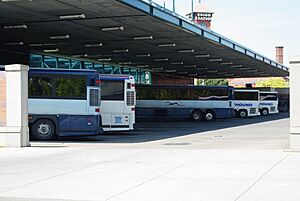
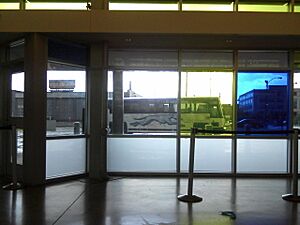
On February 7, 2007, a Scottish transportation company called FirstGroup bought Laidlaw International for $3.6 billion. The deal was completed in October 2007.
After buying Greyhound, FirstGroup worked to improve its image. They updated many bus stations, bought new buses, fixed up old ones, and trained customer service staff. Greyhound also started new advertisements to attract younger travelers and Hispanic customers.
FirstGroup also brought the Greyhound brand to the United Kingdom in 2009, creating Greyhound UK.
In 2008, Greyhound combined its three regional bus operations (Carolina Trailways, Vermont Transit Lines, and Texas, New Mexico & Oklahoma Coaches) into Greyhound Lines.
On March 27, 2008, Greyhound launched a new service called BoltBus. These buses first ran between Boston, New York City, and Washington, D.C.. BoltBus later expanded to the West Coast in 2012, with routes in the Pacific Northwest and California.
Starting in 2009, all new buses bought by Greyhound included three-point seat belts.
In 2010, to compete with other bus companies like Megabus and Chinatown bus lines, Greyhound launched "Greyhound Express." These buses were newer and made fewer stops.
In 2013, Greyhound added video cameras to its entire fleet of buses to improve safety and help drivers.
As of 2014, Greyhound had 1,229 buses serving over 3,800 places in North America.
In 2014, the company introduced a new logo and a new look for its buses, using navy blue and dark gray. Buses were updated with Wi-Fi, power outlets, and leather seats with more legroom.
Before 2014, Greyhound sometimes sold more tickets than there were seats, meaning some passengers had to wait for the next bus. In 2014, Greyhound started using a new computer system to better manage ticket sales and prices. This greatly reduced the number of overbooked buses.
In 2014, Greyhound reported a profit of $73 million. The company said its success was due to changes in city populations and focusing on more popular routes.
From 2013 to 2015, Greyhound expanded its Greyhound Connect service. These routes carried passengers from smaller, rural towns to larger cities. Some of these routes received government funding.
In July 2015, the company announced it would open stations in Monterrey and Nuevo Laredo, Mexico, and start bus service between these cities and Texas. Greyhound said it was the first American bus company to operate a route entirely within Mexico.
Greyhound's "Lucky Streak" brand offers routes to cities with casinos. These tickets are for round-trips, allowing passengers to return whenever they want. Casinos often offer special deals to Lucky Streak passengers.
In February 2020, Greyhound changed its policy and told the Department of Homeland Security that it would no longer allow searches on its buses or in areas of its terminals without a warrant.
In December 2020, the company sold some of its bus stations in Los Angeles, Denver, and Ottawa, Canada, for a total of $137 million.
In May 2021, Greyhound Canada stopped all its bus routes in Canada. Greyhound Lines still operates a few routes that cross the border between the U.S. and Canada.
In July 2021, BoltBus stopped its operations, and Greyhound took over all its routes.
In 2021, several Greyhound bus stations were sold, including those in Columbus, Ohio, Downtown Louisville, and Cincinnati.
In September 2021, the company agreed to pay $2.2 million to settle a lawsuit. The lawsuit was about Greyhound allowing U.S. Customs and Border Protection agents to board its buses in Washington State to conduct immigration checks without warrants.
Under FlixMobility Ownership (2021–Present)
On October 21, 2021, Munich-based Flix SE bought Greyhound for $78 million.
In 2022, FirstGroup sold almost all its remaining Greyhound properties to Twenty Lake Holdings LLC for about $140 million. Some bus stops were moved, which caused some discussion.
Important Incidents and Accidents
Here is a list of some notable incidents and accidents involving Greyhound buses in the United States.
- August 4, 1952: Two Greyhound buses crashed head-on in Waco, Texas. The fuel tanks caught fire, and some people died.
- May 13, 1972: A Greyhound bus crashed with a truck near Bean Station, Tennessee. Several people died, including both drivers. The investigation found the bus driver's passing maneuver caused the crash.
- May 9, 1980: The MV Summit Venture ship hit the Sunshine Skyway Bridge in Florida, causing part of the road to fall into Tampa Bay. A Greyhound bus and other vehicles fell, and people died.
- December 18, 1990: A Greyhound bus was hit by a semi-truck during a snowstorm on I-80 near the Wyoming border. The bus tipped over and slid down a hill. Several passengers died, and many were injured.
- June 20, 1998: A Greyhound bus went off the road near Burnt Cabins, Pennsylvania, and hit a parked truck. Several passengers and the driver died. The investigation found the driver was tired and had used a medicine that made them sleepy.
- October 3, 2001: A passenger attacked the driver of a bus near Manchester, Tennessee, causing the bus to crash. The attacker and five other passengers died, and many were injured. After this, Greyhound temporarily stopped all services and increased security.
- September 30, 2002: A passenger attacked a Greyhound driver near Fresno, California, leading to a crash where two passengers died. After this, Greyhound installed shields and gates on most buses to keep passengers from directly reaching the driver while the bus is moving.
- January 23, 2014: A passenger attacked the driver and grabbed the steering wheel of a bus on Interstate 10 near Tonopah, Arizona. Many passengers were injured. Police praised the driver for keeping the bus upright.
- January 19, 2016: An overnight bus crashed on Highway 101 in San Jose, California. Two people died, and others were hospitalized.
- July 12, 2018: Three Colombian athletes said they were removed from a bus for speaking Spanish. Greyhound stated the passengers were unruly because they wanted to be dropped off at a different location than their ticketed destination.
- August 30, 2018: A Greyhound bus crashed with a semi-truck on Interstate 40 near Thoreau, New Mexico. A tire on the truck blew out, causing it to cross into the bus's path. Several people died, including the driver, and many were injured.
- February 3, 2020: One person died and five were injured when a passenger started shooting on a bus traveling on Interstate 5 near Grapevine, California. The driver pulled over and convinced the shooter to get off the bus.
- February 2, 2022: One person died and four were injured when a passenger started shooting as people were getting off a bus in Oroville, California. The suspect was later arrested.
- July 12, 2023: A Greyhound bus crashed into three semi-trucks parked at a rest area exit ramp near Highland, Illinois. Three people died, and many were seriously injured. The investigation found that driver fatigue was the main cause of the crash.
See also
 In Spanish: Greyhound Lines para niños
In Spanish: Greyhound Lines para niños
- List of Greyhound Bus stations
- Former operating subsidiaries
- Atlantic Greyhound Lines
- Capitol Greyhound Lines
- Dixie Greyhound Lines
- Florida Greyhound Lines
- Great Lakes Greyhound Lines
- Greyhound Canada
- Southeastern Greyhound Lines
- Teche Greyhound Lines
- Museums and preserved stations
- Freedom Rides Museum (Montgomery, Alabama)
- Greyhound Bus Museum (Hibbing, Minnesota)
- Old Greyhound Bus Station (Jackson, Mississippi) (private office)
- Old Greyhound Terminal (Washington, D.C.) (incorporated into building built on site)


